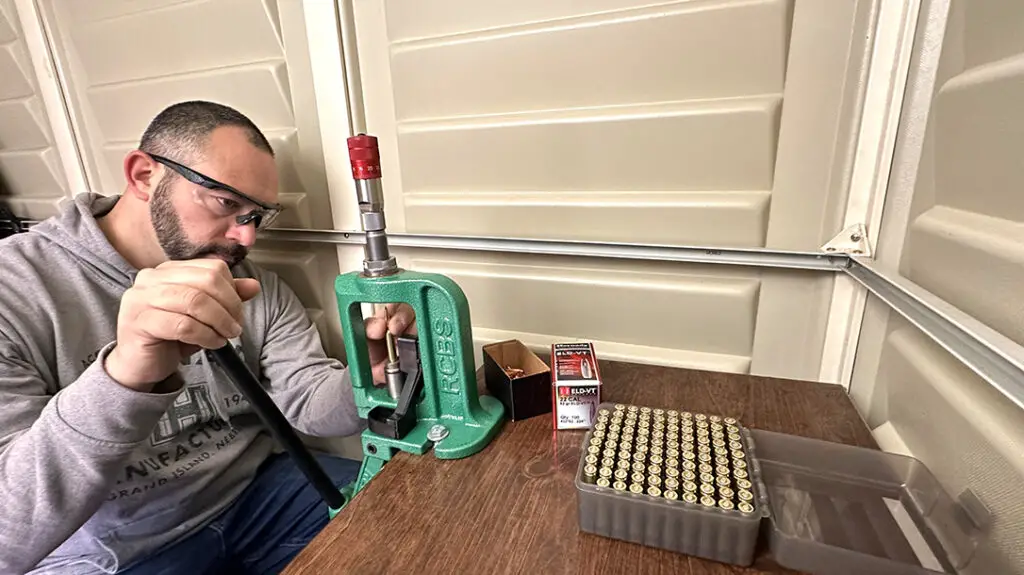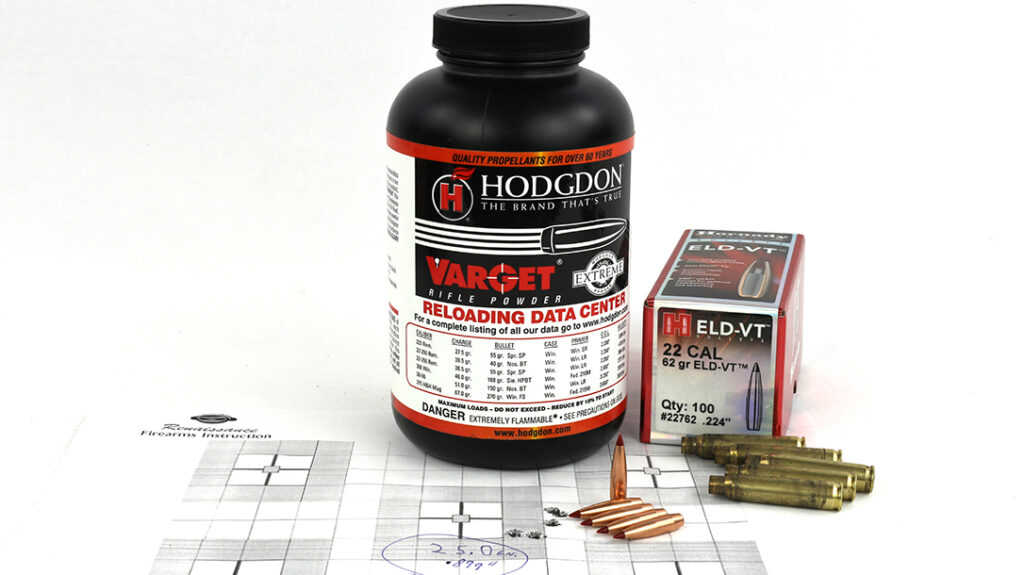
@media (max-width:576px) { .read-more-content { height: 410em; } }
It is much easier to achieve precision shooting when your rifle is paired with one round. It’s not fun to have two different dopebooks or to try to get a sense of wind using two different loads. It’s a simple solution, just as long as you’re ok with that rifle serving a solemn role. This is a bad idea, because rifles designed for matches can also be excellent varmint weapons. Each sport uses projectiles that are designed for different purposes. One is designed to be fast, while the other is meant to resist the wind by increasing mass. Blending the two concepts, Hornady came out with the ELD-VT (eXtremely Low Drag – Varmint Target) product line.
Hornady ELD – VT
We got to test it out at last year’s Athlon Outdoors Rendezvous, sending some downrange via the new .22 ARC cartridge. I was interested in the use of this cartridge in rounds that have been available for a while. So I began my research.
Once I got home and was able skim through the whole line, I began to delve a bit deeper into the bullet family. Some of the bullets were pulled out of their cases, which was a big help. Their profiles mimic today’s lowest drag pills, even to match or exceed the length of heavier offerings of the caliber. They weigh much less due to the thinner jacket, hollow cavity and overall sleekness. As an example, the 62 grain.224 inch projectile is 13 grams lighter but longer than a boattail hollow point pill with the same diameter. These qualities combine to produce faster speeds and better wind resistance on long engagements.
As with everything, the best comes at the cost of something else. All of that length means they’ll only reach full potential in modern cartridges that can accommodate the longer ogives, or at least magazines that allow for greater overall length. Imagine 6 Creedmoor as an alternative to.243 Winchester and 22 ARC as an alternative to.223 Remington. Now, I’m not saying you can’t load these into old standbys; I’m just saying that a whole lot of bullets will be sitting outside of the case and might not fit into a mag. You might experience chambering issues, too, if your rifle doesn’t have enough free bore, but in most cases, you can adjust around that.
ELD-VT Terminal Performance
Let’s talk terminal performance, as that’s where a varmint bullet shines. Being that these feature the same Heat Shield tips as the rest of the ELD family, they’ll arrive on target without suffering the deformation associated with other polymers when they heat up mid-flight. It also helps with the expansion, as the copper jacket is driven into the hollow chamber upon impact. The thinner jacket of the match bullet in the cavity allows it to fragment more easily and with less force, which makes it more explosive when used on softer, thinner targets. Lastly, because the line includes both light and midweight calibers the handloader can drive the bullets to incredible speeds. This will increase the previously mentioned qualities.
As someone who is always up for a project, the assignment that came to my desk was exciting. With pills available for the most common calibers, I told Hornady to send me their first available, and I’d cook something up. It was, as I suspected, the 62 grain.224 inch, which they were producing to meet.22 ARC demands that came along with the introduction the new product line. With a BC of .395, it’s ballistically superior to all other 62- and 68-grain bullets Hornady makes while even giving some of the 73s and 75s a run for their money.
Only one thing was wrong with these: I didn’t have a.22-inch ARC rifle or any other.224″ hot rods. I had a very accurate AR-15 with a bull-barrel, so I chose to use 5.56 for this project. At the same time, I figured I’d keep engineering honest and see if there was any feasible way to make these fit into a standard magazine.

Loading 5.56 AR-15s
You can use any powder with 5.56, it all depends on the weight of bullets you want to run. That’s where things get interesting, as the ELD-VTs are lightweight but fill the bore like they’re much heavier. Hodgdon Varget is my preferred powder for 5.56 heavy.224 inch pills. Varget was my choice because it had a consistent temperature and consistency, even though other powders have faster speeds. I knew that the 24-inch barrel in my rifle would make up for this. This propellant was available in both 75-grain and 62-grain loads. I could confirm my choice by looking at published data. To ensure that I wouldn’t experience an overpressure event, I selected the more conservative powder range and moved on to the rest of the components.
I used to conduct most of my tests on an Air National Guard range. As a result, I always have buckets full of Lake City 5.56 Brass on hand. With the quantity that I’ve collected, I was able to sort it not only by head stamp but also within a grain of each other. These lots are much more consistent and sentimental than any you could buy on the shelf. All that remained was to prime with CCI BR-2 Benchrest primers, and then head to my research facility which resembles a shed in the woods.

Z
To see if it would fit in a magazine, I started with 23.5 grains Varget and sat the bullets in small increments. Even though I had a Duramag, it was not enough to help me. For the round to reach 2.260 inches it had to be sat just below the Ogive. It would almost fall in the case. The surface problem with this is obvious, as the rifle won’t feed, and you’ll have erratic or dangerous pressure levels. However, if that’s not enough to sway you, remember that you’ll lose a tremendous amount of powder capacity doing this. Finally, seating below shoulder/neck intersection introduces variable and additional neck tension.
This round was thrown and I made another with a longer length, 2.480. It chambered. I rolled off four more rounds, warmed up the rifle and then punched my first target group. I’m not a lucky man, so when my first four shots measured less than half MOA, I was pretty excited. The fifth shot, which left the cluster, still produced a 100 yard croup measuring.623 inches. This told me that I was going to get accurate results. I would have stopped there in most load-development projects. However, Hornady built these bullets for speed, and 2,700 feet per second isn’t particularly fast for 5.56.

Need for Speed
The group measured.899-inch, beating the sub-MOA benchmark while exhibiting a standard deviation of just 3.7 and an extreme spread of 9. The group measured at.899 inches, exceeding the benchmark of sub-MOA while showing a standard deviation just 3.7 and a wide spread of 9. It’s a good thing I took a screenshot of the chronograph; otherwise, people wouldn’t believe it! Once I was satisfied with the two loads, I decided to call it a night.
Hornady’s ELD-VT met its promise and produced excellent accuracy and consistency, even in a cartridge built for something else. The borrowed V-Max tech has proven itself for decades, even though I have yet to test it on flesh. I think it will explode the moment it touches fur. Overall, I think this very well could be the only bullet you need to load in your precision rifles, so now it’s just a matter of measuring more powder and stockpiling some ammo!
Hornady Micrometer with Click-Adjustment

Handloaders have the ability to customize the seating depth in order to achieve the best performance, or even for functionality. I used Hornady’s new click-adjust bullet seating micrometer to develop the loads in this piece. The micrometer has a tactile feel, and it is accurate to a thousandth. This tool makes it easy to upgrade your dies by simply twisting the seater plug off and replacing it.
V-Match Ammo Family

Do you want to shoot ELD VTs, but don’t want to roll your rounds yourself? Hornady has you covered. Their new V Match line of ammunition offers the ELD-VTs. Initial loadings include 6 or 22-arc, 6 or 6-6.5 Creedmoor and even 6.5 Grendel. Match-grade brass is used in each cartridge, along with a carefully chosen powder charge. There is nothing easier than picking up a few cases at the local gun store to hit a prairie dog city running.
For more information, please visit hornady.com.
The post Hornady EL-VT: A Blend between Varmint and Match Bullet Design appeared initially on Athlon Outdoors.

